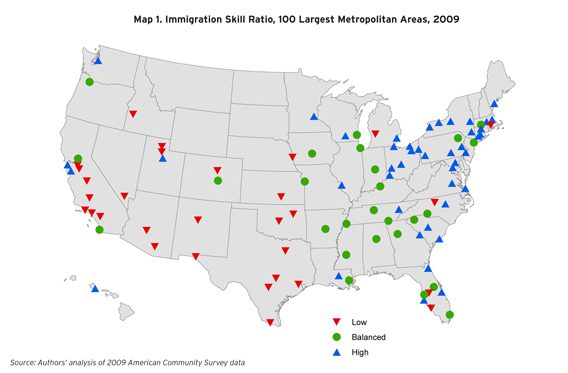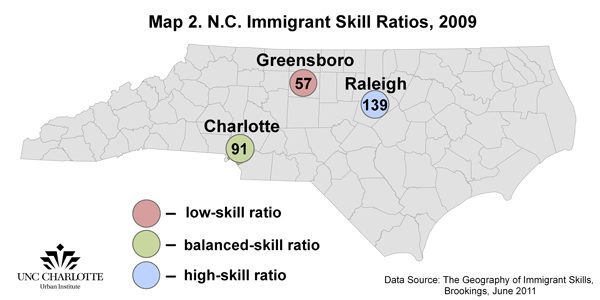New reality: the rise of high-skilled immigrants

When you think of an immigrant, what comes to mind: the person who helped build your house, or the physician discussing your treatment plan? New research indicates that “there are just as many high-skilled as low-skilled working-age immigrants currently living in the United States, and the growth rate of more educated arrivals to the United States now outpaces that of immigrants with little education.” 1
The immigrant skill level varies across cities, however, and this variation affects the debate in the country on immigration reform. In North Carolina, the three cities the research tracked cover the spectrum from high- to low-skilled immigrant destinations. Raleigh is ranked as a comparatively high-skilled immigrant city, Greensboro as a low-skilled immigrant city, and Charlotte as balanced.
A Brookings Institution report released in June tracked immigrant skill levels in the 100 largest U.S. metropolitan regions. The report used a skill ratio based on educational level of the immigrant population with a value of 100 set as an equal number of high- and low-skilled immigrants. Metro regions were then assigned to three groups: low-skill, balanced-skill, or high-skill ratios.2
A focus of the study is on the geographic distribution of these immigrants by skill level (Map 1). The national picture shows many southwestern cities with low-skill ratios and a cluster of northeastern cities with high-skill ratios. N.C. cities have not had a long history of immigration compared to traditional destinations like New York or Miami, and the three N.C. metro areas tracked, Charlotte, Greensboro and Raleigh, are all considered to be similar as more recent, fast-growing immigrant destinations.

Map from The Geography of Immigrant Skills: Educational Profiles of Metropolitan Areas, Brookings, June 2011.
These more recent immigration centers tend to have low-skill ratios, but the Southeast has a mixed set of index scores and a mixed history of immigration activity. Several metro areas in the Southeast with high index ratios like Columbia, S.C., and Augusta, Ga., are considered “low-immigration metros.” Regions in that category tend to have higher skill ratios. Since the three N.C. regions are all considered similar in their immigration profile (recently emerging, high growth in immigrant populations) the differences in their skill ratios is notable (Map 2 below shows the three N.C. cities’ index ratios).

“I think this is an interesting window into the ability of North Carolina cities to attract the creative class,” says UNC Charlotte geography Professor Bill Graves. Graves noted that before the recession, the three cities all attracted workers in sectors that favor low-skilled immigrants, such as construction, but have varied more in sectors that attract high-skilled immigrants.
In spite of the fact that high-skilled immigrants are now as prevalent as those with low skills when measured nationally, the public perception is that most immigrants are low-skilled. The geographical differences in skill levels across the country make that perception more understandable for some regions. Another explanation given in the report is that as the low-skilled population in the U.S. has shrunk overall, immigrants make up a larger and larger share of that group.
The report suggests several strategies to try to deal pragmatically with immigrants while acknowledging the divisiveness of the subject of illegal immigration:
- Create national and state-level commissions on labor and immigration to provide data and inform policy debate, make connections between immigrant groups and labor gaps and identify potential for economic development and entrepreneurship.
- Invest in English-language training which has shown to have multiple benefits across the low and high-skilled immigrant population.
- Develop state and local programs to assist high-skilled immigrants so they can fill needed labor gaps and help regions as economies improve.
In North Carolina, the differences among cities’ immigrant skill level highlights how different the metro economies may be.
As North Carolina’s economy moves out of the doldrums, said UNC Charlotte’s Owen Furuseth, associate provost for Metropolitan Studies, the state needs to actively address the immigrants’ and labor market needs. “Going forward, North Carolina needs the entrepreneurial and technical expertise of immigrants if we are going to compete in a global economy,” he said.
To read the full report and explore the interactive map of the U.S. click here.
Photograph by Nancy Pierce
1The Geography of Immigrant Skills: Educational Profiles of Metropolitan Areas by Matthew Hall, Audrey Singer, Gordon F. De Jong, and Deborah Roempke Graef. Brookings Institution, June 2011.
2Low-skill destinations are metro areas with an immigrant skill ratio below 75 (i.e., fewer than 75 high-skilled immigrants for every 100 low-skilled immigrants); balanced-skill destinations have ratios between 75 and 125 (i.e., relatively comparable numbers of high- and low-skilled immigrants); and high-skill destinations have immigrant skill ratios greater than 125 (i.e., more than 125 high-skilled for every 100 low-skilled immigrants).